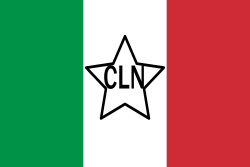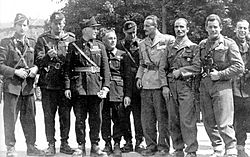Italian resistance movement facts for kids
Quick facts for kids Italian resistance movement |
|
|---|---|
| Participant in the Italian Civil War and World War II | |
 
Flag of the National Liberation Committee and some members of the Italian resistance in Ossola, 1944.
|
|
| Active | Most active 1943–1945; the Resistance originated following the rise of Fascist Italy in the 1920s |
| Ideology | Various: Generally anti-fascism Mainly various forms of communism, socialism, and anarchism; Republicanism and liberalism To a lesser extent: Liberal socialism Christian democracy Catholic anti-fascism / Catholic anti-Nazism Catholic socialism Social liberalism Social democracy Monarchism |
| Allies | |
| Opponents | Axis powers (Fascist Italy, Nazi Germany and Italian Social Republic) |
The Italian resistance movement (Italian: Resistenza italiana or just la Resistenza) is a term for Italian resistance groups during World War II.
It was against the forces of Nazi Germany as well as the Italian Social Republic between September 1943 and April 1945
Known as partisans (Italian: partigiani), the brutal conflict they took part in is called the Italian Liberation War.
Images for kids
-
Partisan monument (Arcevia) with Italian and Yugoslav names
-
A woman executed by public hanging in a street of Rome, early 1944
-
German soldier examining the papers of an Italian civilian outside of Milan (1944)
See also
 In Spanish: Resistencia italiana para niños
In Spanish: Resistencia italiana para niños

All content from Kiddle encyclopedia articles (including the article images and facts) can be freely used under Attribution-ShareAlike license, unless stated otherwise. Cite this article:
Italian resistance movement Facts for Kids. Kiddle Encyclopedia.





